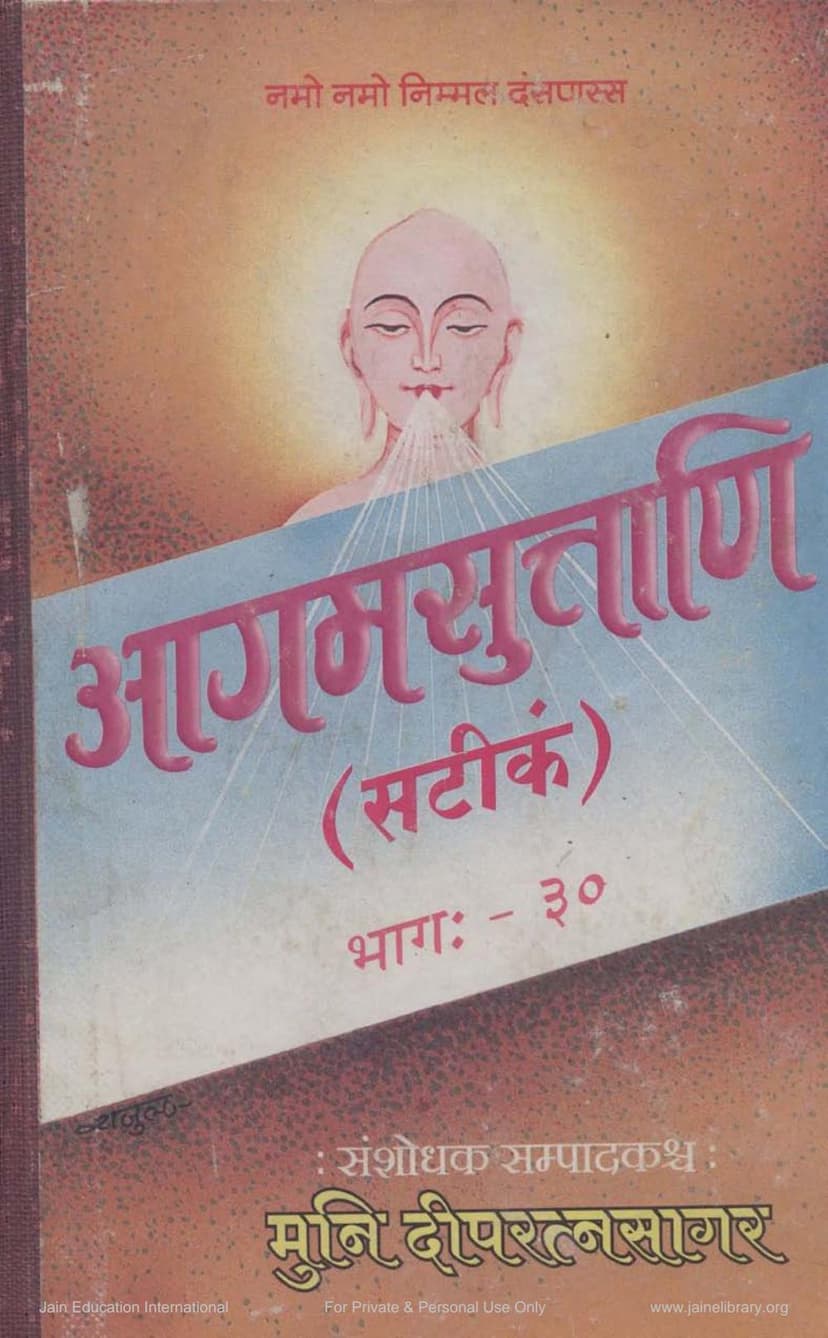Agam Sutra Satik 45 Anuyogdwar ChulikaSutra 2
Added to library: September 1, 2025

Summary
This summary focuses on the contents of the provided Jain text, "Agam Sutra Satik 45 Anuyogdwar ChulikaSutra 2," as described by the table of contents and the initial pages.
Book Title: Agam Sutra Satik (with Commentary) Volume: Part 30 Author/Editor: Muni Deepratnasagar Publisher: Agam Shruta Prakashan Contents: This volume contains two key Chulika Sutras: 1. Anuyogdwar Chulika Sutra: This section focuses on the detailed explanation of the Anuyogdwar Sutra. 2. Nandi Chulika Sutra: This section focuses on the detailed explanation of the Nandi Sutra.
Detailed Breakdown of Contents (based on the Table of Contents):
Nandi Chulika Sutra (Pages 1-163 of this section):
- Praise and Salutations: Begins with invocations and praise of the pure perception, Lord Mahavir, and the gurus.
- Praise of Jainism: Includes praise for the Jain faith, Jinavandana (worship of Jinas), Gana-dhara vandana (worship of the chief disciples), and the Jin Sasana (teachings of the Jinas).
- Staviraavali: A lineage of elders.
- Audience and Assembly: Mentions the listeners (shrota) and the assembly (parshad).
- Types of Knowledge (Jnana):
- Mati-Shrut Jnana (sensory and scriptural knowledge).
- Avadhi Jnana (clairvoyant knowledge).
- Manahparyav Jnana (telepathic knowledge).
- Kevala Jnana (omniscient knowledge).
- Description of Anga Pravishtha Sutra: An explanation of the Anga Pravishtha Sutra.
- Dravya Skandha: Discussion of substance aggregates.
- Upakrama, Nikshepa, etc.: Analysis of introduction, classification, and other aspects.
- Anupurvi: Order or sequence.
- Nayaprarupana: Exposition of logical standpoints (Nayas).
- Pramanaprarupana: Exposition of valid means of knowledge (Pramanas).
- Samaya Vyakhya: Explanation of time.
- Vakhyata: Discourse.
- Nikshepa Vyakhya: Explanation of classification/placement.
- Saptanay Swaroop: The nature of the seven logical standpoints.
- Anugam and Upakrama: Further discussion on sequence and introduction.
- Anuyogdwar Chulika Sutra (Pages 3/1-350 of this section):
- Anuyogdwar Sutra: The main text being elaborated.
- Jnana Vyakhyana: Description of knowledge.
- Nandi Sutra: Detailed description of the Nandi Sutra.
- Upakrama, Nikshepa, Bheda, etc.: Analysis of introduction, classification, types, etc.
- Shruta, Nikshepa Bheda: Scriptural knowledge and its classifications.
- Dravya Skandha, Upakrama, Anupurvi, etc.: Substance aggregates, introduction, sequence, etc.
- Nayaprarupana, Pramanaprarupana: Exposition of Nayas and Pramanas.
- Samaya and other explanations: Details on time, vakhyata (discourse), nikshepa (classification), and the seven nayas.
Anuyogdwar Chulika Sutra:
- Praise and Salutations: Begins with praise for the pure teachings and Lord Sudharma Swami, the fifth Ganadhara.
- Introduction to Anuyogdwar Sutra: The text is presented as the second Chulika Sutra, with a commentary by Malladhari Hemchandrasuri.
- Mangala Sutra: Starts with a verse invoking the principles of auspicious beginnings.
- Definition of Jnana: The text begins by defining knowledge (Jnana) as having five types:
- Abhinibodhika Jnana: Sensory knowledge.
- Shruta Jnana: Scriptural knowledge.
- Avadhi Jnana: Clairvoyant knowledge.
- Manahparyav Jnana: Telepathic knowledge.
- Kevala Jnana: Omniscient knowledge.
- Distinction between Jnana types: The sutra elaborates on the characteristics of each type of knowledge, noting that only Shruta Jnana is subject to specific procedures like "Uddesha" (declaration), "Samuddesha" (detailed exposition), and "Anugama" (sequential elaboration) within the context of Anuyog (discourse). The other four types of knowledge are 'Sthapaniya' (to be set aside or not directly explicated in this context).
- Procedures for Shruta Jnana: The text details the elaborate procedures for initiating the study of Shruta Jnana, including veneration of the Guru, specific meditations, and recitations. These procedures highlight the systematic and respectful approach to acquiring scriptural knowledge in Jainism.
- Discussion on Nayas: The text delves into the importance and application of different Nayas (logical perspectives) in understanding scriptural texts. It discusses how various Nayas like Naigama, Sangraha, and Vyavahara interpret concepts differently.
- Classification of Essentials (Avashyak): The text meticulously classifies 'Avashyak' (essential duties/practices) into four categories:
- Nam Avashyak: Nam-based essentials (referring to the name or concept).
- Sthapana Avashyak: Symbolic or representative essentials.
- Dravya Avashyak: Material or substance-based essentials.
- Bhava Avashyak: Essential practices based on internal state or disposition.
- Detailed classification of these Avashyak: Each category of Avashyak is further broken down and explained with examples, covering various aspects of Jain practice, philosophy, and cosmology. This includes discussions on the nature of substances, time, place, and the subtle classifications of these concepts.
- The Anuyog Process: The text emphasizes that the primary purpose of Anuyog is the detailed exposition and explanation of the scriptural knowledge (Shruta Jnana), a process that involves specific methodologies and is central to Jain learning.
Overall Summary:
The volume "Agam Sutra Satik, Part 30," edited by Muni Deepratnasagar and published by Agam Shruta Prakashan, serves as a comprehensive commentary on key Jain Agamic texts, specifically the Nandi Sutra and the Anuyogdwar Sutra. The text begins with respectful salutations and then systematically lays out the foundational principles of Jain epistemology and practice.
A significant portion of the Nandi Chulika Sutra focuses on the five types of knowledge, highlighting the importance of Shruta Jnana and the intricate procedures associated with its study. The Anuyogdwar Chulika Sutra then elaborates on the concept of 'Avashyak' (essential duties), classifying them into four types and providing detailed sub-classifications. The text also delves into philosophical concepts like Nayas and the nature of substances, time, and existence, demonstrating the depth and systematic approach of Jain thought. The extensive commentary by Malladhari Hemchandrasuri reveals a profound understanding and scholarly tradition within Jainism. The book's extensive listing of financial supporters (arthika anudata) indicates a communal effort and appreciation for preserving and disseminating these sacred texts.